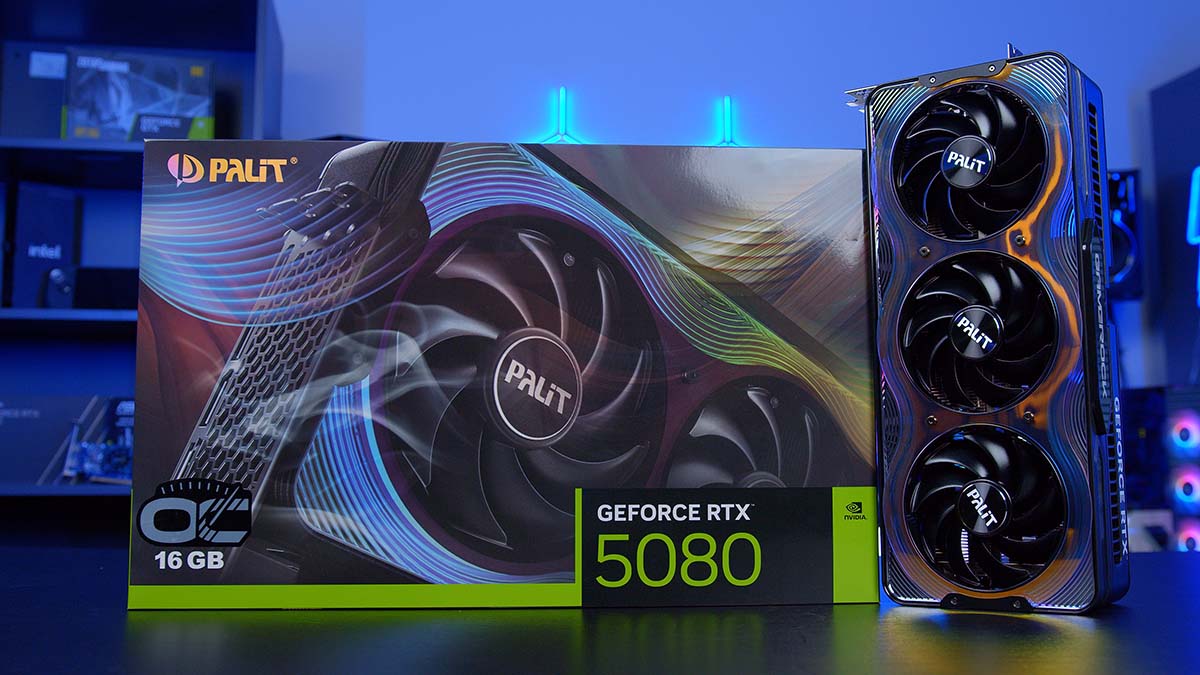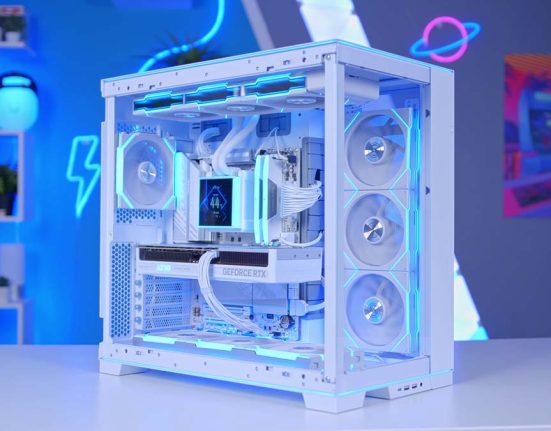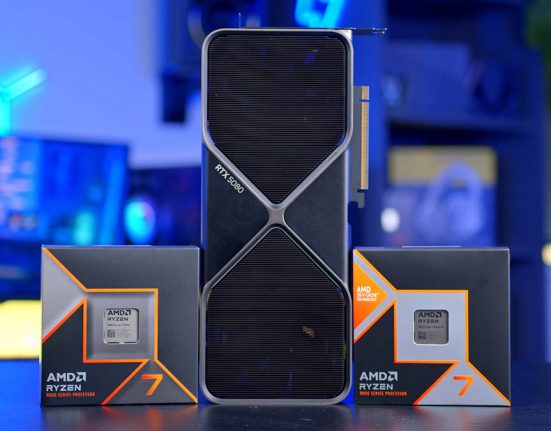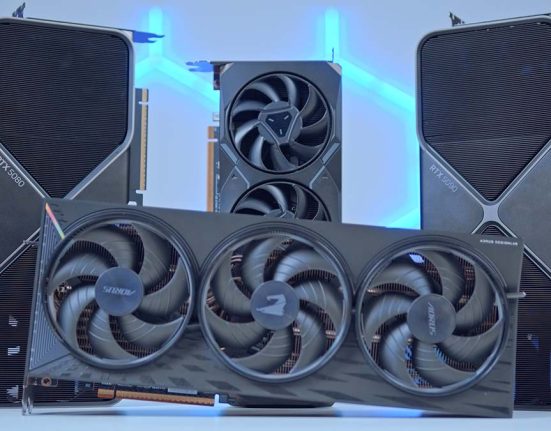The Palit RTX 5080 GameRock OC is one of many AIB graphics cards that have hit the market following the arrival of the RTX 5080. Although the initial response to the Founders Edition RTX 5080 was somewhat mixed, most RTX 5080 cards have sold out across various retailers. This means models like the Palit GameRock OC, Founders Edition, and MSI Vanguard are tricky to pick up until stocks are replenished. Fortunately, Palit kindly sent us their RTX 5080 GameRock OC model, which we’ll look at in today’s review.
The Palit GameRock OC variant of the RTX 5080 is one of the more appealing models due to its unique aesthetic. This particular card offers a considerably different design from the previous generation’s GameRock card. It utilises what Palit describes as a ‘Chameleon panel’, which spans the card’s entire length and offers vibrant RGB lighting. Including a third fan also makes the Palit GameRock OC a more competitive offering regarding thermals, which we’ll cover later.
In today’s review, we’ll explore the specs, design, architecture, thermals, and benchmarking performance of the Palit RTX 5080 GameRock OC to determine whether it’s worth purchasing over some of the more affordable cards.
Specification
As we’ve covered in our other RTX 5080 content, one of the RTX 5080’s USPs (unique selling point) is that it shares the same MSRP (manufacturer suggested retail price) as the RTX 4080 SUPER. This means the RTX 5080 is a fairly natural upgrade for those looking to build a new gaming PC, firming its position as the best 80-class PC over its predecessor. We’d be singing a different tune if NVIDIA priced the RTX 5080 at $1100 or higher.
It is worth noting that following the launch of the RTX 5080 AIB cards, pricing has been pretty poor across the board, but it will improve as stock gets better. Only a handful of 5080 GPUs are available at the all-important MSRP, which isn’t ideal. While this won’t be a deal-breaker for everyone, it makes a $2000 PC build far less achievable. Compared to the rest of the market, the Palit GameRock OC model of the RTX 5080 is pretty expensive, sitting at $1400 or so, depending on the retailer.

The RTX 5080 is a 16GB card that uses blazing-fast GGDR7 VRAM instead of GDDR6X, which has been a mainstay on the RTX 4000 and 3000 series GPUs. This GPU offers a 256-bit memory bus with 10752 CUDA cores, 336 Tensor cores, and 88 RT cores. On paper, the specs of the RTX 5080 are pretty similar to those of the RTX 4080 SUPER, which means that the pure rasterised performance won’t be massively different.
| Key Specs | RTX 5090 | RTX 5080 | RTX 4080 SUPER |
|---|---|---|---|
| Video Memory | 32GB GDDR7 | 16GB GDDR7 | 16GB GDDR6X |
| Memory Bus | 512-bit | 256-bit | 256-bit |
| Base Clock Speed | 2.29GHz | 2.29GHz | 2.29GHz |
| Boost Clock Speed | 2.55GHz | 2.61GHz | 2.55GHz |
| CUDA Cores | 21760 | 10752 | 10240 |
| RT Cores | 170 | 88 | 80 |
| Tensor Cores | 680 | 336 | 320 |
| Power Consumption | 575W | 360W | 320W |
| MSRP | $1999.99 | $999.99 | $999.99 |
Because this is an OC model, the Palit GameRock RTX 5080 has slightly boosted the clock speed to 2.73GHz instead of the base 2.61GHz on MSRP cards. This will uplift performance in specific games and applications.
AI performance is also a major focus for the RTX 5000 range, with the RTX 5080 offering significantly increased AI TOPS performance. This is because the latest generation of DLSS (4.0) arrived alongside the new cards. The Multi Frame Generation technology NVIDIA announced as part of DLSS 4 is far too intensive to work on previous-generation cards. Hence, the AI TOPS capability of the RTX 50 series is a critical factor in this tech’s functioning.
Design
The Palit GameRock RTX 5080 OC is one of the best-looking cards. We decided to use it in a Tower 250 build, which showcases the GPU in all its glory through a window at the side of the case. When powered, the Chameleon panel shines through. Palit’s high-end models have become much more sophisticated over the years, and I’d argue this is one of their strongest models yet.

The most stand-out element of the Palit GameRock OC variant is the unique panel that sits on top of the shroud around the fans. Palit has created a mesmerising optical camouflage effect that looks dazzling once the card is switched on and all of the RGB lighting is enabled. The RGB can be customised using Palit’s ThunderMaster software, or if you plan on tinkering a bit more, SignalRGB allows you to play with individual LEDs across your entire system.

In terms of size, the Palit GameRock RTX 5080 OC is a triple-slot GPU with three fans, allowing it to push more air through compared to a dual-fan model. As a triple-slot card, the Palit GameRock OC variant is also fairly large in length, coming in at a whopping 331mm, so clearance will be an issue in some smaller cases. For this reason, we recommend planning ahead to avoid any installation problems.

Aside from the Chameleon panel around the fans, the rest of the card is black and relatively plain, likely to avoid taking away from the visual experience of the card upfront. This means the Palit GameRock OC is a card better displayed vertically instead of traditional horizontal mounting, as you’ll see the lighting effects in all their glory. Regardless of how the card is installed, we also advise using the included GPU bracket to alleviate any sag, as this is a rather large GPU.
Architecture
The RTX 5000 series is based on the Blackwell architecture, which powers the latest version of DLSS and NVIDIA’s years of machine learning and AI. DLSS 4.0 is, unfortunately, exclusive to the RTX 5080 and its siblings, but this isn’t entirely different from what happened with the RTX 4000 series and the introduction of DLSS 3. DLSS 4 improves performance when switched on, lessening overhead even more than before and allowing gamers to leverage higher framerates. Additionally, NVIDIA has introduced a new version of Frame Generation, Multi Frame Generation.

To break this down while minimising the tech jargon, Multi Frame Generation uses NVIDIA’s numerous years of experience in AI to generate more frames aggressively. Where traditional Frame Generation (or Frame Gen 2x) generates one frame between two rasterised frames, Multi Frame Generation generates three extra frames, so for every one frame, you get three. Doing this massively uplifts frame rates across supported games.
It’s worth noting that Multi Frame Gen isn’t free performance. It doesn’t work the same way DLSS does; it alleviates overhead, allowing the GPU to push harder. Multi Frame Generation is adding artificial frames to your game, making it smoother.

Adding Multi Frame Generation has a latency cost, but mileage will vary between games. We’ve found that in the Hogwarts Legacy system, latency hovered around 2ms, but in Cyberpunk 2077, it was at 16ms. This won’t necessarily matter as much in AAA games, but in a title where responsiveness is key, like Marvel’s Rivals or COD Black Ops 6, it may be worth avoiding turning on Multi Frame Gen.
Performance & Thermals
In this section, we’ll look at the gaming benchmarks and thermal performance of a selection of RTX 5080 models. We’ve tested the Palit GameRock OC and compared it against the MSI VANGUARD and Founders Edition variants of the RTX 5080 to see their major differences.
Cyberpunk 2077
Settings: 4K, Shadow Quality High, Indirect Lighting High, Reflections High, Crowd Density High, Particle Quality High, Volumetric Lighting High, Motion Blur off, GTAO Quality High, Grass Quality High, Contact Shadows High VSync Off, DLSS: On/Off, Ray Tracing: On/Off, Textures: High
Our first game was Cyberpunk 2077, in which we tested the RTX 5080 variants with DLSS and Ray Tracing enabled. In this run, the Palit GameRock OC variant came out on top with a 65FPS average, followed by the MSI VANGUARD at 64FPS. It’s no surprise to see the FE model at the bottom with a 62FPS average, but obviously, the difference compared to the Palit GameRock OC is minimal.
Temperatures-wise, MSI’s VANGUARD RTX 5080 beat the Palit GameRock OC and Founders Edition cards with a 59°C average. While the 63°C result on the Palit GameRock OC isn’t concerning, the MSI VANGUARD is proving to be a better option if you’re prioritising thermals.

After switching on the controversial Multi Frame Gen setting, average FPS skyrocketed across the board, with the Palit GameRock OC coming out on top with 200FPS; the higher boost clock speed is paying dividends here. Temperatures remained similar across the board, with the Palit model dropping by 1°C. It’s interesting to see the difference boost speed makes here, as the FE model, which utilises the baseline specs, loses out by 10FPS.

Hogwarts Legacy
Settings: 4K Effects High, Material High, Fog High, Sky High, Foliage High, Post Process High, Shadows High, Textures High, View Distance High, Population High, Anti Aliasing TAA High, Windowed Fullscreen
In Hogwarts Legacy at 4K high, results across the cards in this benchmark are reasonably similar. Palit is a clear winner yet again with a 105FPS average, followed by MSI at 103FPS and the FE card at 101FPS. Temperatures slightly improve in Hogwarts Legacy with the MSI VANGUARD RTX 5080 sitting at 57°C with Palit and NVIDIA at 61°C and 62°C, respectively.

Marvel Rivals
Settings: 4K, Graphics Quality High, Global Illumination Lumen GI- High Quality, Reflection Quality Screen Space Reflections, Model Detail High, Post-Processing High, Shadow Detail High, DLSS On/Off, Frame Gen On/Off
Firing up Marvel Rivals at 4K with Multi Frame Gen enabled, the Palit GameRock OC version of the RTX 5080 sits at the top of the graph with a 330FPS average. The Palit card was incredibly strong in this run beating out the MSI VANGUARD model by 27FPS. Again, temperatures are perfectly fine here. MSI wins with a 56°C average while the NVIDIA FE RTX 5080 sits at 58°C, coming up close behind.

COD Black Ops 6
Settings: 4K, Graphics Preset Custom, Texture Resolution High, Depth of Field On, Detail Quality High, Particle Resolution High, Shader Quality High, Shadow Quality High, Screen Space Shadows High, DLSS On/Off, Frame Gen On/Off
In our COD Black Ops 6 benchmark performance wasn’t as impressive. We don’t tend to use DLSS in this game because it doesn’t massively impact performance, so we decided to run a rasterised test. The Palit GameRock RTX 5080 OC leads the fore with a 117FPS average while temperatures remained at 52°C. The MSI VANGUARD RTX 5080 card sits at 53°C in this benchmarking run, slightly beating out MSI. The Founders Edition unfortunately sits at the bottom of the graph with a 103FPS average, while temperatures hovered around 56°C.

Conclusion
Palit GameRock RTX 5080 OC
Product Name: GameRock RTX 5080 OC
Brand: Palit
-
Features
-
Design
-
Performance
-
Value For Money
Summary
The Palit GameRock RTX 5080 OC is one of the RTX 5080 models that I’d recommend picking up compared to the broader market of options. Unsurprisingly, the leading quality that makes this card stand out is its design. The Chameleon panel on the front of the card is incredibly unique and provides an interesting way to showcase RGB while offering mesmerising patterns. No other cards offer anything similar, so it puts the Palit GameRock OC version of the RTX 5080 in a strong position compared to other AIB cards.
That said, there are some caveats. The main two are pricing and stocking. Since the launch of the RTX 5080, cards have been out of stock, and while this will likely improve, it makes cards like the Palit GameRock OC incredibly difficult to pick up and more expensive due to scalping and a general lack of options. However, if you’re looking for a showpiece graphics card, the GameRock RTX 5080 OC from Palit is well worth considering.
Pros
✅ One of the best performing cards
✅ Gorgeous design
✅ Vibrant RGB
Cons
❌ Expensive
❌ Weaker thermals than FE model
❌ May cause clearance issues







![FI_[DM78] Corsair Air 5400 + 5090 Gaming PC Build](https://geekawhat.com/wp-content/uploads/2025/11/FI_DM78-Corsair-Air-5400-5090-Gaming-PC-Build-551x431.jpg)
